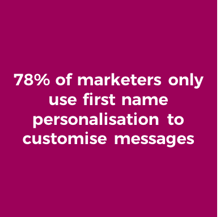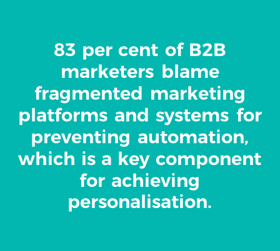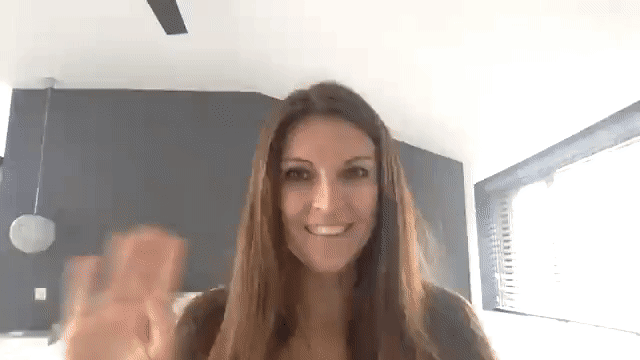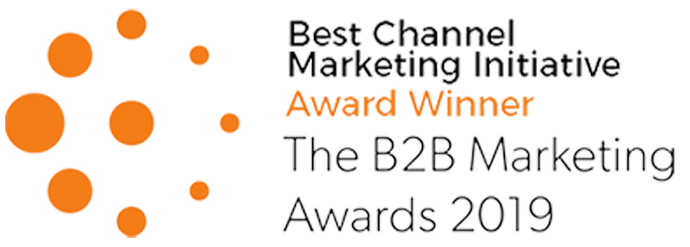 Marketing is a smelting pot of different tactics, trends, tools, platforms and strategies all swirling around together. Some of these sink to the bottom, some bubble to the top and others combine to make an entirely new blend altogether. Personalisation is one of the ingredients in this marketing mix which seems to have been bubbling away for years. It could be described as the seasoning in the pot…when used in isolation, it is entirely unpalatable; but when added to other ingredients, it enhances the entire flavour and magic can happen.
Marketing is a smelting pot of different tactics, trends, tools, platforms and strategies all swirling around together. Some of these sink to the bottom, some bubble to the top and others combine to make an entirely new blend altogether. Personalisation is one of the ingredients in this marketing mix which seems to have been bubbling away for years. It could be described as the seasoning in the pot…when used in isolation, it is entirely unpalatable; but when added to other ingredients, it enhances the entire flavour and magic can happen.
Personalisation was originally associated with direct mail and was often abused slightly by marketers who enjoyed flouting their new toy! I once worked on a project where personalisation became a bone of contention as one member of the team had inserted the recipient’s first name in to every paragraph of the copy, rendering the letter somewhat disingenuous. “Hi John, we notice you’ve previously purchased a ticket, John. Why not let us help you out again John?”. No, no, no.
So, how have things changed? Well, first of all, personalisation moved in to the digital space which changed the game entirely. Initially this involved every marketer sticking the recipient’s first name at the beginning of every email, but the difficulty came with managing the juxtaposition between a person’s assumed online anonymity and the vast digital footprint they leave behind. However, through the development of technology, managing this dichotomy has become far easier and the opportunities available to get to know your audiences better and offer them a more personalised customer experience are endless.
 Secondly, personalisation was adopted by the B2B world. This opened a whole new can of worms, as the B2B user journey often has many more touch points and a complexity that appears to make personalisation more difficult to achieve. It requires real-time access to audience data across various touchpoints throughout their journey, so marketers may have to invest in technology to plug any gaps. However, creating buyer personas is a great way to create segmentation and serve personalised content based on information such as job title, industry vertical/sector, management level and budgetary responsibility.
Secondly, personalisation was adopted by the B2B world. This opened a whole new can of worms, as the B2B user journey often has many more touch points and a complexity that appears to make personalisation more difficult to achieve. It requires real-time access to audience data across various touchpoints throughout their journey, so marketers may have to invest in technology to plug any gaps. However, creating buyer personas is a great way to create segmentation and serve personalised content based on information such as job title, industry vertical/sector, management level and budgetary responsibility.
 Dynamic web content is a great example of serving personalised content. Through automation and behavioural marketing, leads can be served content appropriate to where they are in their customer journey, creating an enhanced experience. This is important as the B2B decision making process often involves numerous decision makers and therefore pushing individuals towards a sale at the wrong point will just alienate them. Instead, use personalisation to enable them and create a personalised customer experience that creates conversation, which they may wish to share with colleagues. In fact, Hubspot discovered that personalised CTAs converted 202% better than default versions, as they were specific to the customer’s needs at the optimum point in the purchase cycle.
Dynamic web content is a great example of serving personalised content. Through automation and behavioural marketing, leads can be served content appropriate to where they are in their customer journey, creating an enhanced experience. This is important as the B2B decision making process often involves numerous decision makers and therefore pushing individuals towards a sale at the wrong point will just alienate them. Instead, use personalisation to enable them and create a personalised customer experience that creates conversation, which they may wish to share with colleagues. In fact, Hubspot discovered that personalised CTAs converted 202% better than default versions, as they were specific to the customer’s needs at the optimum point in the purchase cycle.
Personalised email is still going strong, with 90% of survey respondents stating that personalisation is used in their email marketing. However, many have moved beyond “Hey John” and are finding dynamic content, to be their most effective personalisation tactic. In the same report by One Spot, they found that 60% of marketers say real-time data in email (e.g. contextual info like location or weather) is either ‘effective’ or ‘highly effective’. The same response was given by 58% of respondents in relation to machine learning driving email personalisation. However, you don’t need automation to speak directly to your customers. Why not use the tools you have available to identify your prospective customers and speak directly to them using video? There are numerous free tools available, which will allow you to record short messages and send them directly through your email provider…I have used Vidyard to provide you with an example here:
 This is a great way to stand out in very crowded inboxes, whilst providing value to your customers. You can even track their interaction with your video and send them a personalised email to follow up. This could be especially useful when running ABM programmes as you will have identified your customer’s pain points and will be eagerly trying to serve them appropriate solutions at the appropriate time whilst building relationships. ABM is highly targeted and your messaging needs to reflect this. Be personal, create a good experience and build trust. I’m going to highlight the importance of this with some stats!
This is a great way to stand out in very crowded inboxes, whilst providing value to your customers. You can even track their interaction with your video and send them a personalised email to follow up. This could be especially useful when running ABM programmes as you will have identified your customer’s pain points and will be eagerly trying to serve them appropriate solutions at the appropriate time whilst building relationships. ABM is highly targeted and your messaging needs to reflect this. Be personal, create a good experience and build trust. I’m going to highlight the importance of this with some stats!
In a survey of over 206 digital marketers, 96% of respondents praised the ability of personalisation to advance customer relationships, 61% said personalisation has helped them achieve a superior customer experience and 88% said it has helped them realise a measurable lift in business results.
I’ll leave you with the wisdom of Evergage CEO, Karl Wirth, who states that there are four key principles of user experience – ‘remember me, understand me, help me and surprise/delight me’. How are you going to do any of those if you don’t get personal?!
To chat about using personalisation in your marketing or running ABM programmes, please get in touch on 01234 964000 or letschat@sherpamarketing.co.uk.
post by topic
- ABM (31)
- Sherpa News (28)
- News (27)
- Demand Generation (20)
- Online Marketing (18)
- Inbound Marketing for Technology Companies (15)
- Channel Marketing (13)
- Content Marketing Strategy (12)
- Channel Transformation (11)
- sales and marketing alignment (11)
- Blended Sales & Marketing (9)
- Lead Follow-Up (9)
- Lead Management (8)
- Social Media (8)
- personalisation (8)
- Customer Relationship Management (CRM) (7)
- Lead Scoring (7)
- Martech (6)
- Buyers' Journey (5)
- Technology Marketing (5)
- Optimisation (4)
- email (4)
- Resellers (3)
- SEO (3)
- The IT Marketing Agency (3)
- channel agency (3)
- video (3)
- CSR (2)
- Charity Events (2)
- PX (2)
- Partner Experience (2)
- Team (2)
- Website Data (2)
- Data (1)
- Events (1)
- Harvard Business Review (1)
- birthday (1)
- customer experience (1)
- hubspot (1)
- marketing automation (1)



.png)
.png)
